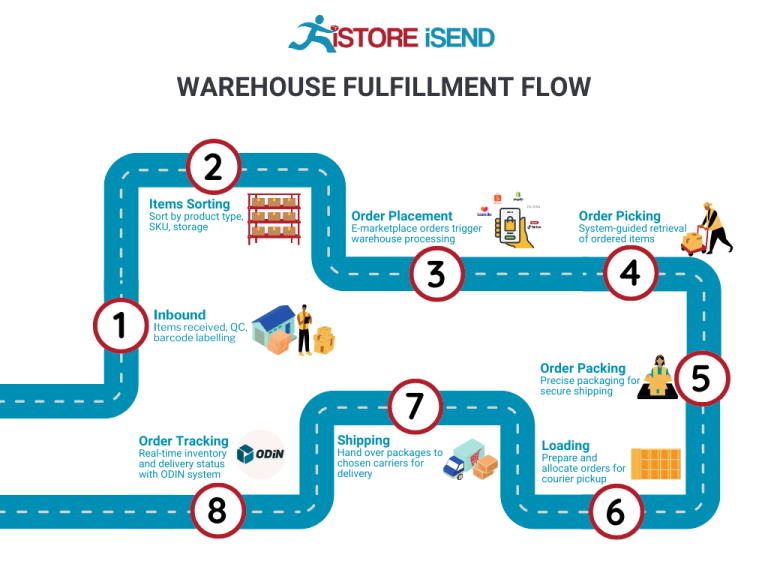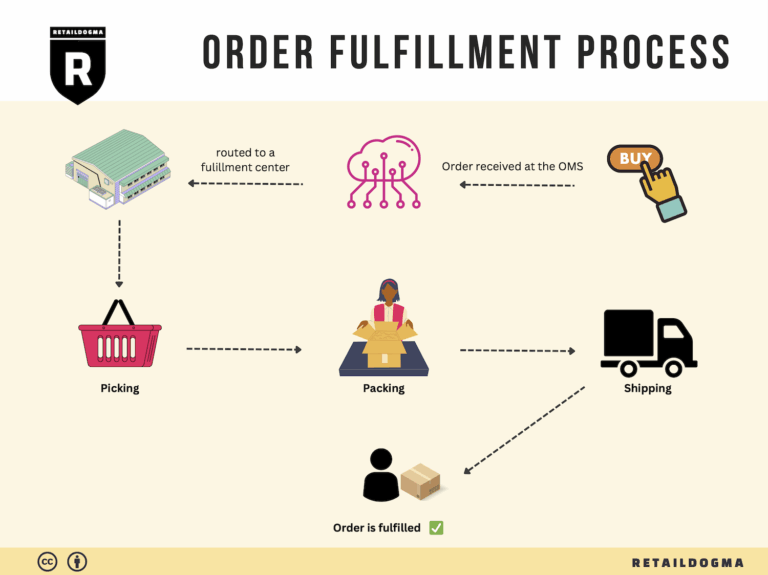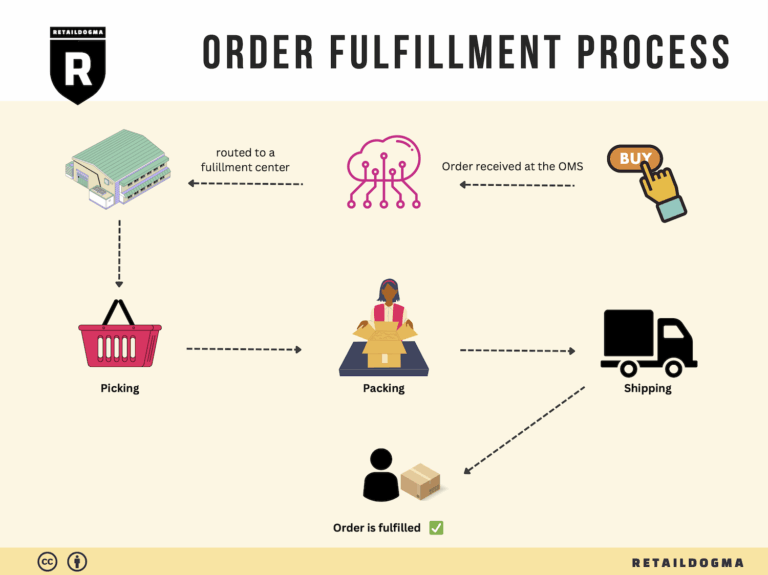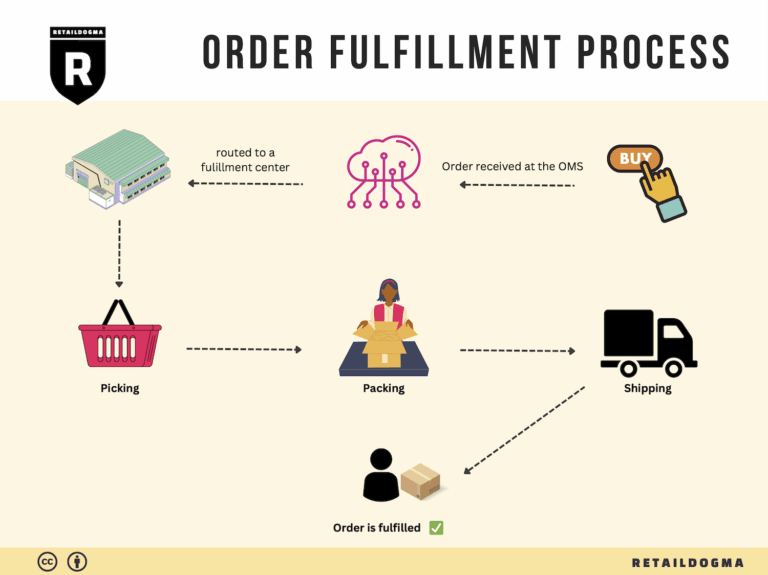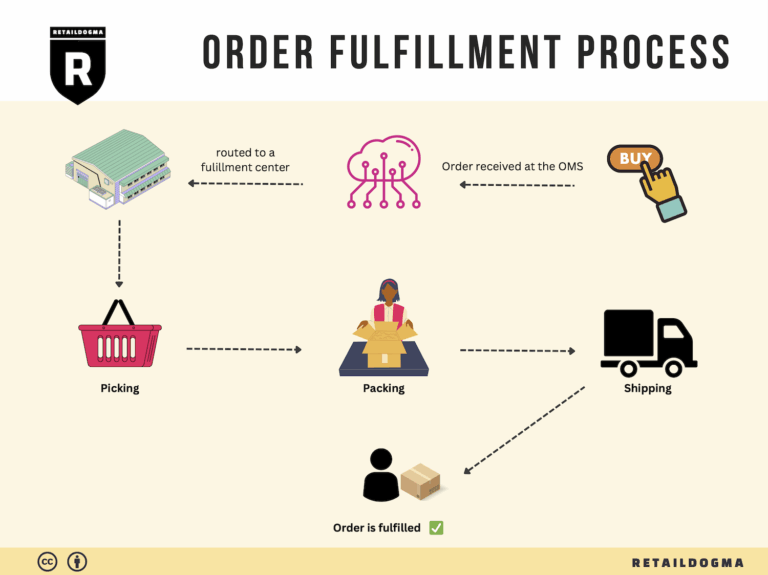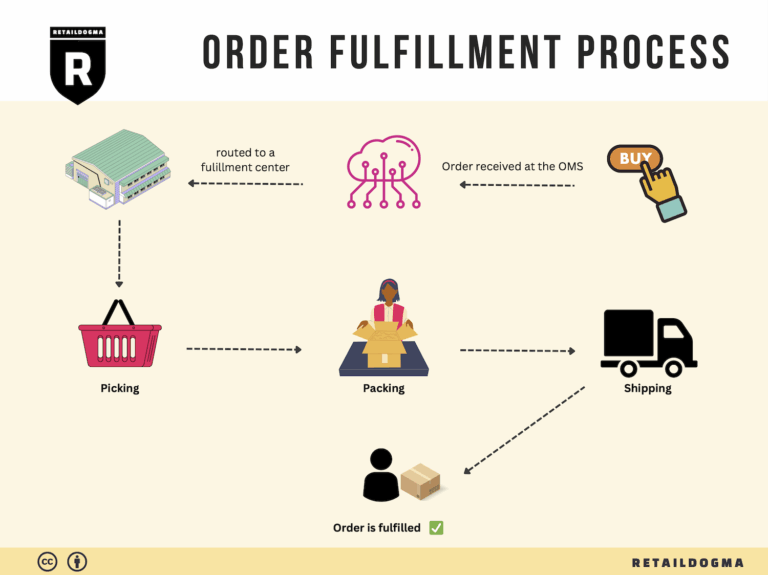Ecommerce Fulfillment Services: The Ultimate Guide (2025)
What is E-commerce Fulfillment? An Introduction for Growing Businesses
The Challenge of Order Fulfillment for Growing Businesses
As your e-commerce business expands, you may find yourself overwhelmed by the logistics of packing and shipping orders. The excitement of growth can quickly turn into frustration when faced with the complexities of order fulfillment. Whether you’re managing orders from your website, social media channels, or multiple marketplaces, the process of getting products into customers’ hands can be daunting.
At its core, e-commerce fulfillment is simply the process of delivering a product to a customer. This involves several key steps: receiving inventory, storing products, picking and packing orders, and shipping them out. For growing businesses, mastering this process is essential not only for customer satisfaction but also for maintaining operational efficiency and profitability.
This guide aims to demystify e-commerce fulfillment, providing you with the knowledge needed to scale your logistics effectively. We will explore different fulfillment models, including third-party logistics (3PL) and Fulfillment by Amazon (FBA), detailing how each option can align with your business goals. Understanding these models will help you identify which one suits your operational needs and customer expectations.
In addition to models, we will discuss the core services involved in the fulfillment process, such as inventory management, order processing, and shipping options. By gaining insights into these services, you can make informed decisions about what to prioritize in your fulfillment strategy.
Choosing the right fulfillment partner is crucial for your business’s success. This guide will outline the key criteria to consider when selecting a logistics provider, including scalability, reliability, and cost-effectiveness. We will also dive into the pricing structures associated with various fulfillment options, helping you understand the potential costs and benefits involved.
Ultimately, this guide aims to empower you to make smart, strategic decisions regarding your logistics operations. By understanding the intricacies of e-commerce fulfillment, you can streamline your processes, enhance customer satisfaction, and support sustainable growth for your business. Let’s get started on the journey to mastering your fulfillment strategy!
What You’ll Learn In This Guide
- What is E-commerce Fulfillment? An Introduction for Growing Businesses
- The Order Fulfillment Process: From ‘Buy’ Button to Customer’s Door
- Comparing Fulfillment Models: In-House vs. 3PL vs. Dropshipping
- A Deep Dive into Amazon FBA: Pros, Cons, and Who It’s For
- Core Services Offered by Fulfillment Centers
- How to Choose a Fulfillment Partner: A 6-Point Checklist
- Understanding Fulfillment Pricing: A Breakdown of Common Fees
- Frequently Asked Questions (FAQs) about Fulfillment
- Conclusion: Is Outsourcing Fulfillment the Right Move for Your Business?
- Important Disclaimer
The Order Fulfillment Process: From ‘Buy’ Button to Customer’s Door
1. Receiving Inventory
The order fulfillment process begins with receiving inventory at the fulfillment center. This step is crucial as it sets the foundation for the entire fulfillment operation. When products arrive, they are checked against purchase orders to ensure that the right quantities and items have been delivered.
Key terms associated with this step include SKU (Stock Keeping Unit), which is a unique identifier for each product variant that helps in tracking inventory. Properly receiving inventory involves confirming that the SKUs match the order, inspecting for damages, and logging them into the inventory management system.
Efficient receiving processes help minimize errors and discrepancies in inventory levels, which can lead to stockouts or overstock situations. By ensuring accuracy at this stage, businesses can streamline subsequent steps and maintain customer satisfaction.
2. Warehouse Storage
Once the inventory is received and logged, the next step is warehouse storage. Proper organization within the warehouse is vital for optimizing the picking and packing processes later on. Products are stored based on various strategies such as ABC analysis, where items are categorized based on their sales frequency and value.
A key term here is bin location, which refers to the specific area within the warehouse where a product is stored. Implementing an effective bin location system aids in reducing search times when orders are picked.
In addition, leveraging technology such as Warehouse Management Systems (WMS) can enhance visibility of inventory levels and locations, allowing for better decision-making regarding restocking and order fulfillment strategies.
3. Order Picking
Order picking is the process of retrieving items from their storage locations to fulfill customer orders. This step is critical, as it directly impacts the speed and accuracy of order fulfillment. Efficient picking methods, such as batch picking or zone picking, can be employed depending on the volume and nature of orders.
The pick list is a fundamental tool in this stage, detailing the items and quantities needed for each order. It serves as a guide for warehouse staff to ensure that the right products are selected.
Accuracy in order picking is paramount; errors at this stage can lead to incorrect shipments, resulting in returns and dissatisfied customers. Investing in training for staff and utilizing technology like barcode scanning can significantly reduce picking errors and improve overall efficiency.
4. Order Packing
After items have been picked, they must be packed for shipment. This step involves carefully placing products into packaging to ensure they are protected during transit. Proper packing not only safeguards the items but also enhances the customer’s unboxing experience.
Key considerations during packing include selecting appropriate packaging materials, such as boxes, bubble wrap, or eco-friendly options, depending on the product type and fragility. Using a packing slip, which outlines the contents of the package, can also improve customer satisfaction by ensuring transparency.
Effective packing processes help reduce shipping costs and minimize damage claims. Additionally, packing strategically can optimize space utilization within shipping containers, leading to cost-effective transportation solutions.
5. Shipping & Delivery
The final step in the order fulfillment process is shipping and delivery. Once packages are packed, they are labeled and handed off to carriers for transportation to the customer’s address. This stage is critical for customer satisfaction, as timely and accurate deliveries significantly influence the overall shopping experience.
Key terms associated with this step include shipping methods (e.g., ground, air, express) and tracking numbers, which allow both the business and the customer to monitor the shipment’s progress.
Efficient shipping strategies, such as partnering with reliable carriers and optimizing routes, can enhance delivery speed and reduce costs. Additionally, offering multiple shipping options can cater to diverse customer needs, thereby improving retention and loyalty.
In conclusion, understanding and optimizing each step of the order fulfillment process—from receiving inventory to shipping and delivery—can significantly impact a business’s operational efficiency and customer satisfaction levels. Implementing best practices and leveraging technology at each stage will position e-commerce businesses for growth and scalability in an increasingly competitive marketplace.
Comparing Fulfillment Models: In-House vs. 3PL vs. Dropshipping
Fulfillment Model Comparison
| Model | Who Handles Inventory | Best For (Business Stage) | Key Advantage | Key Disadvantage |
|---|---|---|---|---|
| In-House Fulfillment | The business itself | Startups and established brands | Full control over inventory and processes | High operational costs and resource-intensive |
| Third-Party Logistics (3PL) | A third-party provider | Growing businesses and scale-ups | Scalable, flexible, and expertise in logistics | Less control over inventory and potential hidden fees |
| Dropshipping | Supplier/manufacturer | New entrants and niche retailers | Low initial investment and minimal risk | Lower profit margins and reliance on supplier quality |
In-House Fulfillment
In-house fulfillment involves managing the entire logistics process within your own organization. This means that you handle everything from inventory storage to order processing and shipping. For startups or established brands that want to maintain tight control over their supply chain and customer experience, this model can be advantageous. Businesses can customize processes to meet their specific needs, ensuring that product quality and customer service standards are upheld. However, this approach often comes with significant operational costs, including warehouse space, staffing, and technology investments. As a business scales, these costs can become burdensome, making it challenging to maintain profitability, especially during peak seasons. Additionally, in-house fulfillment requires a robust infrastructure and can divert focus from core business activities such as marketing and product development.
Third-Party Logistics (3PL)
Third-party logistics (3PL) providers offer a comprehensive solution for businesses looking to outsource their fulfillment operations. In this model, a specialized logistics company manages inventory storage, order processing, and shipping on behalf of the business. This allows companies to leverage the expertise and established networks of 3PL providers, making it an ideal choice for growing businesses or those looking to scale rapidly. The key advantages include flexibility in handling seasonal demand fluctuations and access to advanced technology and logistics capabilities without the need for significant upfront investments. However, businesses may face challenges with control over inventory management and potential hidden fees that can affect overall profitability. Additionally, reliance on a third party can lead to issues if the provider does not meet service expectations, impacting the customer experience.
Dropshipping
Dropshipping is a fulfillment model where the retailer does not hold inventory but instead relies on suppliers to ship products directly to customers. This approach is particularly appealing to new entrants or niche retailers who want to minimize financial risk and avoid the complexities of inventory management. With dropshipping, businesses can offer a wide range of products without the overhead costs associated with warehousing and logistics. However, the model comes with its own set of challenges. Profit margins are typically lower due to the reliance on suppliers, and businesses may face issues related to product quality, shipping times, and inventory availability. Furthermore, the lack of control over fulfillment processes can lead to inconsistencies in customer experience, making it crucial for retailers to choose reliable suppliers and maintain open lines of communication to mitigate these risks.
Conclusion
Choosing the right fulfillment model is a critical decision that can significantly impact your e-commerce business’s growth and operational efficiency. Each model—whether in-house fulfillment, third-party logistics, or dropshipping—has its unique advantages and disadvantages, making it essential for business owners to carefully evaluate their current stage, resources, and long-term goals. Understanding these differences can help e-commerce businesses make informed decisions that align with their strategic objectives and customer expectations.
A Deep Dive into Amazon FBA: Pros, Cons, and Who It’s For
Understanding Fulfillment by Amazon (FBA)
Fulfillment by Amazon (FBA) is a service provided by Amazon that allows sellers to store their products in Amazon’s fulfillment centers. Amazon then takes care of storage, packaging, and shipping of products directly to customers. This service is particularly beneficial for e-commerce businesses looking to streamline their logistics and reach a larger audience without the overhead of managing their own fulfillment operations.
When a customer orders a product, Amazon handles all aspects of the transaction, including customer service and returns. Sellers can focus on other essential business functions, such as marketing and product development, while relying on Amazon’s robust logistics network to fulfill orders.
How FBA Works
-
Setup: Sellers sign up for an Amazon Seller account and choose the FBA option. They then send their inventory to Amazon’s designated fulfillment centers.
-
Storage: Products are stored in Amazon’s warehouses. Sellers are charged monthly storage fees based on the volume of space their inventory occupies.
-
Order Fulfillment: When a customer places an order, Amazon picks the product from the warehouse, packs it, and ships it directly to the customer. This process typically includes fast shipping options, such as next-day or two-day delivery for Prime members.
-
Customer Service: Amazon manages all customer service inquiries and handles returns, allowing sellers to focus on their core business activities.
-
Payment: After the sale is completed, Amazon disburses the funds to the seller, minus applicable fees.
Pros of Fulfillment by Amazon (FBA)
Prime Eligibility
One of the most significant advantages of using FBA is that products become eligible for Amazon Prime. This status attracts a larger customer base who are willing to pay for Prime membership, as they expect fast and reliable shipping options. Prime members often prioritize products that offer free and expedited shipping, which can significantly boost sales.
Customer Trust
Amazon’s established reputation for reliability and customer service is a major benefit for FBA sellers. When products are fulfilled by Amazon, customers are more likely to trust the transaction, knowing that they can rely on Amazon’s return policies and customer support. This trust can lead to higher conversion rates and repeat purchases.
Multi-Channel Fulfillment
FBA also integrates seamlessly with Amazon Multi-Channel Fulfillment (MCF), allowing sellers to fulfill orders from other sales channels (such as their own website or other marketplaces) using Amazon’s logistics network. This capability simplifies inventory management and allows businesses to leverage Amazon’s shipping speed across multiple platforms.
Cons of Fulfillment by Amazon (FBA)
High Fees
While FBA can simplify logistics, it comes with a range of fees that can eat into profit margins. These include storage fees, fulfillment fees, and additional charges for long-term storage and peak season surcharges. Sellers need to carefully calculate these costs to ensure that using FBA is financially viable.
Strict Inventory Rules
Amazon has stringent rules regarding inventory management. Sellers must comply with guidelines on how products are packaged and labeled. Non-compliance can lead to additional fees or inventory being returned. Moreover, managing inventory levels can be challenging, especially during peak seasons, as overstock can incur high storage fees.
Commingling Risks
When using FBA, sellers’ inventory may be commingled with that of other sellers. This means that when a product is ordered, Amazon may ship a unit from a different seller’s inventory. This can lead to issues such as counterfeit concerns and difficulty in managing returns, as the seller may receive returns for products they did not sell.
Who is FBA Best For?
Fulfillment by Amazon is particularly suitable for small to medium-sized e-commerce businesses looking to scale their operations without the burden of managing their own fulfillment centers. It is ideal for:
-
Brands with High Volume Sales: Businesses that anticipate high order volumes and want to leverage Amazon’s logistics capabilities.
-
Sellers with Diverse Product Ranges: Companies offering a variety of products can benefit from FBA’s ability to manage different inventory types and sizes under one roof.
-
Startups and New Sellers: New entrants to the e-commerce market can utilize FBA to gain visibility and credibility without needing to establish their own fulfillment infrastructure.
-
Businesses Seeking Growth: Companies aiming to expand their reach through Amazon’s marketplace can benefit from the exposure and trust associated with FBA.
In conclusion, Fulfillment by Amazon offers a comprehensive solution for e-commerce businesses looking to enhance their logistics and customer service. By weighing the pros and cons, sellers can determine if FBA aligns with their business model and growth aspirations.
Core Services Offered by Fulfillment Centers
Inventory Management & Warehousing
Inventory management and warehousing are foundational services offered by fulfillment centers. This involves the storage of products in strategically located warehouses, which can significantly impact your supply chain efficiency. Fulfillment centers employ sophisticated inventory management systems that help businesses track stock levels in real time, manage reorder points, and optimize storage space.
Benefits:
1. Cost Efficiency: By utilizing a fulfillment center’s warehouse, businesses can reduce overhead costs associated with maintaining their own storage facilities. This includes savings on rent, utilities, and maintenance.
2. Scalability: As your e-commerce business grows, so does your inventory. Fulfillment centers provide the flexibility to scale up or down based on seasonal demands or sales fluctuations without the need for long-term commitments.
3. Improved Accuracy: Advanced inventory management systems reduce the likelihood of human error, ensuring that stock levels are accurate. This leads to better fulfillment rates and fewer backorders or stockouts, enhancing customer satisfaction.
4. Space Optimization: Fulfillment centers can efficiently utilize warehouse space through strategic shelving and storage techniques, allowing for a greater variety of products to be stored and accessed quickly.
Pick and Pack Services
Pick and pack services are crucial for fulfilling customer orders accurately and efficiently. This process involves selecting items from the warehouse (picking) and then packing them securely for shipment (packing). Fulfillment centers utilize advanced technology and trained staff to streamline this process.
Benefits:
1. Speed: Fulfillment centers often employ automated systems and trained personnel to ensure that orders are picked and packed quickly, reducing lead times and improving the overall customer experience.
2. Customization: Businesses can offer personalized packaging options, such as branded boxes or custom inserts, which enhance brand recognition and customer loyalty.
3. Error Reduction: With barcoding and scanning technology, fulfillment centers minimize picking errors, ensuring that the correct products are shipped to customers, which is essential for maintaining trust and satisfaction.
4. Scalability: As order volumes fluctuate, fulfillment centers can adjust their workforce and processes to meet demand without compromising service quality.
Kitting and Assembly
Kitting and assembly services involve combining multiple products into a single package or preparing items for sale. This could include assembling furniture, bundling products for promotions, or creating gift sets. Fulfillment centers can handle these tasks efficiently, allowing businesses to offer unique product offerings without the logistical burden.
Benefits:
1. Enhanced Product Offerings: Kitting allows businesses to create bundled products, which can be marketed at a premium price. This not only increases average order value but also attracts customers looking for convenient purchasing options.
2. Time Savings: By outsourcing kitting and assembly to a fulfillment center, businesses can focus on core activities like marketing and customer service instead of spending time on manual assembly.
3. Quality Control: Fulfillment centers often have quality assurance processes in place to ensure that kitted products meet specified standards before they are shipped, reducing the risk of returns due to defects or incorrect items.
4. Inventory Management: Kitting can help streamline inventory management by reducing the number of individual SKUs, simplifying stock tracking and replenishment.
Returns Management (Reverse Logistics)
Returns management, or reverse logistics, is an essential service provided by fulfillment centers. This involves handling the return of products from customers back to the warehouse, processing returns, and managing restocking or disposal of items. A seamless returns process is crucial for customer satisfaction and retention.
Benefits:
1. Customer Satisfaction: A straightforward and efficient returns process enhances customer trust and loyalty. Fulfillment centers often provide return labels and manage the logistics of returns, making it easier for customers to return items.
2. Cost-Effectiveness: By centralizing returns processing at a fulfillment center, businesses can reduce the costs associated with handling returns in-house, such as labor and transportation expenses.
3. Data Insights: Fulfillment centers can provide valuable analytics on return trends, helping businesses understand why products are returned and allowing for informed decision-making regarding product development, quality control, and customer service improvements.
4. Restocking Efficiency: Fulfillment centers can quickly assess returned items and determine if they can be restocked or if they need to be repaired or disposed of, ensuring that inventory levels remain accurate and up-to-date.
In summary, the core services provided by fulfillment centers—inventory management and warehousing, pick and pack services, kitting and assembly, and returns management—are critical for e-commerce businesses aiming to scale operations efficiently. Leveraging these services not only enhances operational efficiency but also contributes significantly to customer satisfaction and retention. By partnering with a fulfillment center, businesses can focus on growth and strategy while leaving the logistics to the experts.
How to Choose a Fulfillment Partner: A 6-Point Checklist
Location & Warehouse Network
Importance: The geographic location of a fulfillment partner’s warehouses directly impacts shipping times and costs. The closer your inventory is to your customers, the faster and more cost-effective your deliveries will be. This is particularly crucial for businesses that promise expedited shipping, as customers increasingly expect quick delivery times.
Questions to Ask:
– Where are your warehouses located, and how many do you operate?
– Can you provide details on the shipping zones you cover?
– How does your location influence shipping costs and delivery times for my target market?
– Do you have plans for expanding your network in the near future?
Technology & Integrations
Importance: Efficient order fulfillment relies on robust technology and seamless integrations with your e-commerce platforms. A partner with advanced technology can provide real-time tracking, inventory management, and order processing capabilities, enhancing your operational efficiency and customer satisfaction.
Questions to Ask:
– What software do you use for inventory management, and how can it integrate with my e-commerce platform?
– Can you provide real-time tracking capabilities for both me and my customers?
– How do you handle inventory updates and order processing?
– What kind of reporting and analytics can I expect from your system?
Specializations (e.g., cold storage, oversized items)
Importance: Depending on your product type, specific fulfillment capabilities may be necessary. If you sell perishable goods, fragile items, or oversized products, you’ll need a partner that specializes in those areas to ensure your items are stored and shipped correctly.
Questions to Ask:
– Do you have specialized facilities for my product type (e.g., cold storage, handling fragile items)?
– What protocols do you have in place for managing specialized inventory?
– How do you ensure compliance with regulations relevant to my products?
– Can you provide examples of clients with similar product needs?
Scalability & Capacity
Importance: As your business grows, your fulfillment needs will evolve. Choosing a partner with scalability ensures that you can accommodate increased order volumes without compromising service quality. A partner’s capacity to handle fluctuations during peak seasons is also essential for maintaining customer satisfaction.
Questions to Ask:
– What is your current capacity for handling orders, and how do you manage peak seasons?
– How quickly can you scale operations in response to my business growth?
– Are there any limitations on the types or volumes of products you can handle?
– Can you share examples of how you have scaled for other clients during busy seasons?
Pricing and Contracts
Importance: Understanding the pricing structure is critical for forecasting your fulfillment costs accurately. A transparent pricing model helps avoid unexpected fees that can erode margins. Additionally, the terms of the contract should align with your business goals and flexibility needs.
Questions to Ask:
– Can you provide a detailed breakdown of your pricing structure, including any hidden fees?
– What is your policy for price adjustments during contract renewal?
– Are there minimum order requirements or long-term commitments?
– How do you handle situations where my needs change mid-contract?
Customer Support & Reviews
Importance: Reliable customer support is essential for addressing issues quickly and maintaining operational efficiency. A partner with a strong reputation for customer service can help you navigate challenges smoothly. Reading reviews and testimonials can provide insight into their reliability and service levels.
Questions to Ask:
– What customer support channels do you offer (e.g., phone, email, live chat)?
– Can you guarantee a dedicated account manager for my business?
– How do you handle service disruptions or issues with order fulfillment?
– Can you provide references or case studies from similar businesses you’ve partnered with?
Conclusion
Selecting the right fulfillment partner is a critical decision that can significantly impact your e-commerce operations and customer satisfaction. By using this checklist, you can methodically evaluate potential partners based on your specific needs and ensure you choose one that aligns with your growth strategy. Take the time to ask the right questions and gather all necessary information before making a decision to set your business up for success.
Understanding Fulfillment Pricing: A Breakdown of Common Fees
Initial Setup Fees
When you first engage with Amazon Multi-Channel Fulfillment (MCF), there may be initial setup fees involved. These fees are typically charged for account creation, integration with your existing sales channels, and configuring your inventory management system. Depending on the complexity of your setup, these fees can vary significantly. While some businesses may encounter minimal charges if they are integrating with standard platforms like Shopify or WooCommerce, others with custom solutions may face higher fees due to additional technical support or configuration requirements. It’s crucial to clarify these fees upfront to avoid unexpected costs as you begin your fulfillment journey.
Receiving Fees
Receiving fees are incurred when you send inventory to Amazon’s fulfillment centers. These fees cover the handling and processing of your goods as they arrive at the warehouse. Amazon charges a fee per unit for receiving inventory, which includes unloading, scanning, and storing the items in their system. The fee structure is typically tiered based on the size and weight of the items being received. For example, small items may incur lower fees compared to oversized products. Understanding the receiving fees is essential for budgeting your overall fulfillment costs, especially if you plan to send large quantities of stock.
Storage Fees (per pallet/bin)
Storage fees are a recurring cost that is calculated based on the amount of space your inventory occupies in Amazon’s warehouses. These fees are typically charged monthly and can vary depending on the time of year. During peak seasons, such as the holiday shopping period, storage fees may increase significantly due to heightened demand for warehouse space. Amazon calculates storage fees based on cubic feet, and businesses must factor in both standard and long-term storage fees, the latter being applicable if inventory remains unsold for an extended period (usually over 365 days). To manage storage costs effectively, it’s wise to monitor inventory turnover and strategically plan your stock levels.
Pick & Pack Fees (per item/order)
Pick and pack fees are charged for each order fulfilled by Amazon. This fee covers the labor involved in selecting (picking) the items from the shelves and packing them for shipment. Amazon calculates these fees based on several factors, including the size and weight of the items, the number of units per order, and the chosen shipping speed. For instance, larger and heavier items will typically incur higher pick and pack fees. Additionally, there are tiered discounts available for multi-unit orders, which can help reduce costs when fulfilling larger orders. Understanding this fee structure is vital, as it directly impacts your profitability, especially during high-volume sales periods.
Shipping Fees
Shipping fees represent the costs associated with delivering your products to customers. Amazon MCF offers various shipping options that can affect the overall shipping costs. Fees are calculated based on the destination, weight, and dimensions of the package, as well as the selected shipping speed (e.g., standard, two-day, or next-day delivery). It’s important to note that shipping fees can fluctuate based on seasonal demand; for example, during peak shopping seasons, there may be additional surcharges. Additionally, international shipping incurs extra fees, making it crucial for businesses targeting global customers to thoroughly understand these costs.
Conclusion: Tips for Getting an Accurate Quote
To ensure you receive an accurate quote for your fulfillment needs with Amazon MCF, consider the following tips:
-
Detailed Inventory Assessment: Begin by accurately assessing your inventory’s size, weight, and volume to ensure that storage and shipping fees are calculated correctly.
-
Understand Your Sales Channels: Clarify which channels you will integrate with Amazon MCF, as this affects receiving and fulfillment fees.
-
Factor in Seasonal Variations: Be aware of how storage and shipping fees may change during peak seasons and plan your inventory levels accordingly.
-
Request a Breakdown of Fees: When seeking quotes, ask for a detailed breakdown of all potential fees, including initial setup, receiving, storage, pick and pack, and shipping fees.
-
Consult with an Expert: If possible, engage with a consultant or fulfillment expert who can provide insights based on your specific business model and needs.
By following these strategies, you can gain a clearer understanding of your fulfillment pricing and make informed decisions that support your business growth.
Frequently Asked Questions (FAQs) about Fulfillment
1. What is Amazon Multi-Channel Fulfillment (MCF)?
Amazon Multi-Channel Fulfillment (MCF) is a service that allows sellers to store their inventory in Amazon’s fulfillment centers and have orders fulfilled from these centers for sales made across various channels, not just on Amazon. This service is particularly beneficial for e-commerce businesses that sell on multiple platforms, as it streamlines order fulfillment while leveraging Amazon’s extensive logistics network.
2. How does Amazon MCF differ from Fulfillment by Amazon (FBA)?
While both MCF and FBA involve storing products in Amazon’s warehouses, FBA is designed exclusively for orders placed on Amazon.com, providing quick shipping options like next-day and two-day delivery. MCF, on the other hand, can fulfill orders from other channels, such as your own e-commerce site or other marketplaces, but may not always offer the same expedited shipping options.
3. How does the fulfillment process work with Amazon MCF?
The fulfillment process with Amazon MCF involves several steps:
1. Inventory Storage: Sellers send their products to Amazon’s fulfillment centers.
2. Order Integration: Orders from integrated sales channels are automatically sent to Amazon.
3. Picking and Packing: Amazon staff pick, pack, and prepare the orders for shipment.
4. Shipping: Orders are shipped to customers, with shipping options available based on the seller’s preferences.
4. What are the costs associated with using Amazon MCF?
Costs for Amazon MCF include:
– Storage Fees: Monthly fees based on the space your inventory occupies, with higher rates during peak seasons.
– Fulfillment Fees: Charges per order based on product size, weight, and shipping speed.
– Additional Fees: Inbound fees for receiving inventory, removal fees for taking inventory out of Amazon’s warehouses, and surcharges for international shipping.
5. What is a 3PL (Third-Party Logistics) provider?
A 3PL provider is a company that offers outsourced logistics services, including warehousing, order fulfillment, and distribution. Unlike Amazon MCF, which is specific to Amazon’s network, a 3PL can manage logistics across various platforms and may provide more flexible options tailored to a business’s unique needs.
6. How do I integrate my sales channels with Amazon MCF?
To integrate your sales channels with Amazon MCF, you will need to connect your e-commerce platform (like Shopify or BigCommerce) to your Amazon Seller Central account. Amazon provides tools and APIs to facilitate this integration, allowing for seamless order processing across your various sales channels.
7. Can I fulfill international orders using Amazon MCF?
Currently, Amazon MCF primarily supports domestic fulfillment within the U.S., with some exceptions for media items like books and DVDs. Orders shipped outside of the U.S. incur significant surcharges, making it less viable for international shipping unless you are selling specific media products.
8. What are the storage limitations with Amazon MCF?
Amazon MCF has specific storage limitations that vary based on product size and weight. Sellers may incur long-term storage fees if inventory remains unsold for an extended period. It’s essential to monitor your inventory levels and turnover rates to avoid unnecessary fees.
9. How does Amazon prioritize orders between FBA and MCF?
Amazon prioritizes orders fulfilled through FBA over those fulfilled through MCF. This means that during peak times or high demand periods, MCF orders may experience delays, as FBA orders are processed first. Sellers should consider this when planning their inventory and fulfillment strategy.
10. What are the best practices for using Amazon MCF effectively?
To maximize the benefits of Amazon MCF, consider the following best practices:
– Optimize Inventory Management: Regularly monitor stock levels and turnover to minimize storage fees.
– Choose the Right Shipping Options: Offer a mix of shipping speeds to cater to different customer needs.
– Integrate Sales Channels: Ensure seamless integration between your sales channels and Amazon to streamline order processing.
– Plan for Peak Seasons: Prepare for increased storage and fulfillment costs during holiday seasons by adjusting inventory levels ahead of time.
– Evaluate Alternatives: Periodically assess whether MCF continues to be the best fit for your business or if exploring other 3PL options may provide better flexibility and cost savings.
Conclusion: Is Outsourcing Fulfillment the Right Move for Your Business?
The Case for Outsourcing Fulfillment
Outsourcing your fulfillment can be a transformative decision for your e-commerce business. By leveraging a fulfillment service like Amazon Multi-Channel Fulfillment, you can save valuable time and resources that can be redirected towards growth and innovation. Fulfillment services streamline logistics, allowing you to focus on core business functions such as marketing, product development, and customer engagement.
One of the most significant benefits of using a fulfillment partner is scalability. As your sales increase, a fulfillment service can easily accommodate the surge in order volume without the need for you to invest in additional infrastructure or staff. This flexibility ensures that you can grow your business without the operational headaches that often accompany rapid expansion.
Moreover, fulfillment centers bring specialized expertise to the table. They understand the intricacies of logistics, inventory management, and shipping regulations, enabling you to benefit from their knowledge and technology. This expertise can lead to enhanced customer satisfaction through faster shipping times and improved order accuracy, which are critical components in today’s competitive landscape.
However, the success of your outsourcing strategy hinges on choosing the right fulfillment partner. Look for a provider that aligns with your business goals, offers transparent pricing, and has a proven track record in your industry.
To determine if outsourcing fulfillment is the right step for your business, conduct a thorough audit of your current shipping and logistics processes. Evaluate your pain points and identify areas where a fulfillment partner could provide significant advantages. By assessing your needs and exploring potential partners, you can make an informed decision that paves the way for sustainable growth. Consider this strategic move as an investment in your business’s future success.
Important Disclaimer
⚠️ Important Disclaimer
The information in this guide is for educational purposes. Fulfillment services, pricing, and platform features change frequently. Always conduct your own due diligence and consult with providers directly before making business decisions.
